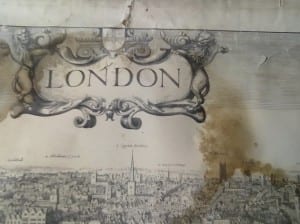Guest blog: Old London Bridge: Recovery from Disaster
By Krisztina Lackoi, on 26 October 2012
GUEST BLOG: DAVID JONES
Old London Bridge: Recovery from Disaster
On Tuesday 9th October David Jones, Paper conservator, UCL Special Collections, curated a Pop-up display ‘Old London Bridge: Recovery from Disaster’. Sections of a 17thC panorama of London before and after extensive conservation treatment were presented and discussed in the context of the Art Museum’s current exhibition ‘One Day in the City’. Below is David’s account of this fascinating object and the process involved in bringing it back to life following severe flood damage.
UCL Libraries’ Special Collections hold not only a vast amount of extraordinary bound materials, but also treasures like this London panorama. This is Robert Martin’s 1832 lithograph copied from the Wenceslaus Hollar engraving published in 1647 A View of London from Bankside.
Little is known about where this print came from and how it got to UCL – there are no markings on the frame or the print itself and it’s difficult to trace its history. One theory is that it was acquired as part of the London History Collection, but its history remains a mystery. It seems to have been stored in the basement space in the Science Library for many years – the building was acquired in 1967, and the basement has been used as a store for various Library items ever since.
The piece was found in a wooden frame at the back of one of the rooms and dismantled as part of the conservation project when Nick Shepley, co-curator of the One Day in the City exhibition, had a look at it and showed interest in using it. The room was in the past particularly prone to flash flooding following heavy downpours, and the print had been severely damaged by flooding. Of course it’s equally possible that the object was damaged even before 1967. (It should be pointed out that the drainage system has since been repaired.)
After careful cleaning and backing removal, one of the four panels of the View was removed and could then be treated to reduce the unsightly and prominent water blotches (tide lines).
Once testing established that the ink on the print would not run when exposed to water, we could proceed with the most dramatic stage of the conservation process: immersion washing in water. Ironically, the best treatment for objects with flood damage is complete immersion in water. Warm London tap water is ideal for conservation use because of its slightly basic pH and good lime content.
Once the print had been washed, it was dried, lightly pressed to flatten and minor tears were repaired using conservation grade Japanese tissue. Conservation details such as length of time immersed in water and water temperature were documented so that the remaining three sections of the panorama may be treated for a consistent result in the future, and the entire View of London may eventually be restored to its full glory.
6 Responses to “Guest blog: Old London Bridge: Recovery from Disaster”
- 1
- 2
-
3
Kathy Luek wrote on 13 November 2012:
What a difference your efforts made. I appreciate seeing the before and after photos. Keep on conserving, it benefits everyone.
- 4
-
5
Martin wrote on 21 May 2013:
This is lovely to see, more so because I look at the full width lithograph by Robert Martin 1932 everyday up on my wall
-
6
vincent burgess wrote on 22 May 2014:
I purchased a full robert martin/holler view of london a number of years ago. It was tightly rolled had some water damage and completly covered in a yellow varnish. After a number of trials I paintakingly, with various scaple blades, managed to remove the varnish. Unfortunatly it left a yellowish residue over the remaining surface. I’ve tried applying various liquid solutions in order to remove, but without success. Does anyone have any suggestions?
 Close
Close




Fascinating stuff! Thanks for letting us enjoy this peep behind the stage.